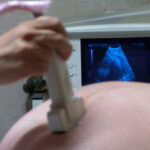There is nothing more joyous than expecting a much wanted and loved baby. Each milestone is noted by the parents such as a positive pregnancy test, the heartbeat when first heard with a Doppler and the ultrasound screening usually performed at 20 weeks gestation. However, this joy can turn into heartache when an anomaly is detected on ultrasound. One abnormality that may be identified at the 20 week screening is polydactyly.
What is Polydactyly?
Polydactyly is the presence of more than the usual five fingers and five toes per hand and foot. This abnormal number of fingers and toes may occur on its own, be a dominantly inherited trait that involves one gene, or it may occur in conjunction with various genetic diseases.
What is Done When Polydactyly is Discovered in Utero?
When polydactyly is discovered in utero it is important for the expectant mother to be referred to a Maternal-Fetal Medicine Specialist for a comprehensive ultrasound. This will determine if other abnormalities exist in conjunction with polydactyly that may be indicative of a chromosonal abnormality or a genetic disease.
Some defects that can be seen on ultrasound are a cleft lip and palate, microcephaly (small head), congenital heart defects, and short limbs. If others abnormalities are detected by ultrasound, or based on a mother’s age (35 or older) even if no other problems are detected, an amniocentesis is usually warranted.
What is an Amniocentesis?
Amniocentesis is a prenatal test that allows the physician and the expectant mother to gather information regarding the baby’s health. Amniotic fluid, which surrounds the baby in utero, is collected with a large needle inserted into the mother’s uterus. This procedure is performed along with an ultrasound to ensure proper placement of the needle and to determine the location of the baby. The fluid is then analyzed to determine if a chromosonal or genetic problem exists.
What Chromosonal or Genetic Problems May Exist in Conjunction with Polydactyly?
In most cases polydactyly occurs with no explanation and is not caused by chromosonal or genetic abnormalities. When polydactyly is an isolated defect the extra digit or digits can either be tied off at birth, if the digit or digits are rudimentary and attached by a small stalk, or corrected by surgery during childhood if the digit is well-formed and possibly functional.
Polydactyly can also be familial (an inherited trait). African Americans, more than any other ethnicity, have polydactyly as an inherited dominant trait. In most cases this does not indicate a genetic disease or chromosonal problem.
In a few cases polydactyly is an additional abnormality in conjunction with other defects. In these instances there may be a chromosonal or genetic disorder. Some of these disorders are Ellis-van Creveld syndrome, Rubinstein-Taybi syndrome, Trisomy 13, Asphyxiating thoracic dystrophy, and Carpenter Syndrome. These are usually severe and in the case of Trisomy 13 incompatible with life.
Conclusion
Polydactyly is one of the most common birth defects. Many cases of polydactyly are not reported because the extra digit or digits are rudimentary and tied off after birth. Even if the extra digit is well formed and functional surgery can usually be performed in early childhood to remove the extra digit.
When polydactyly is discovered in utero it is important for the mother to be seen by a Maternal-Fetal Medicine Specialist for an in-depth ultrasound to make certain that other defects are not present. If other abnormalities are discovered than an amniocentesis can be performed to discover if a genetic disease or a chromosonal problem exists.




